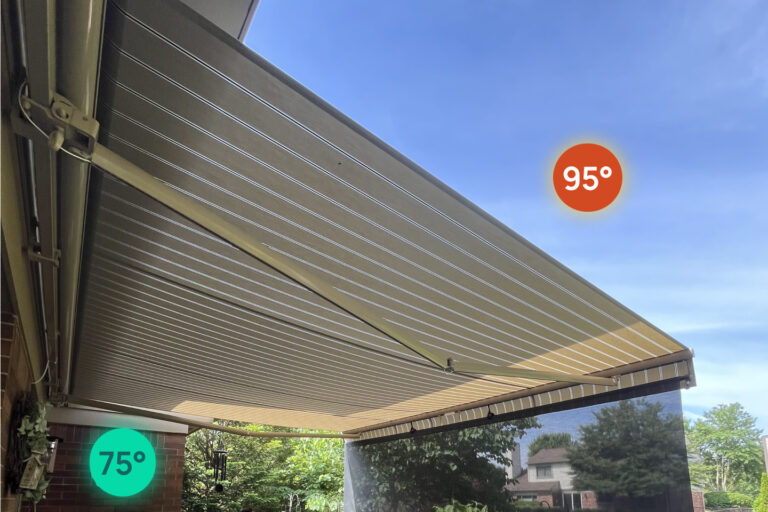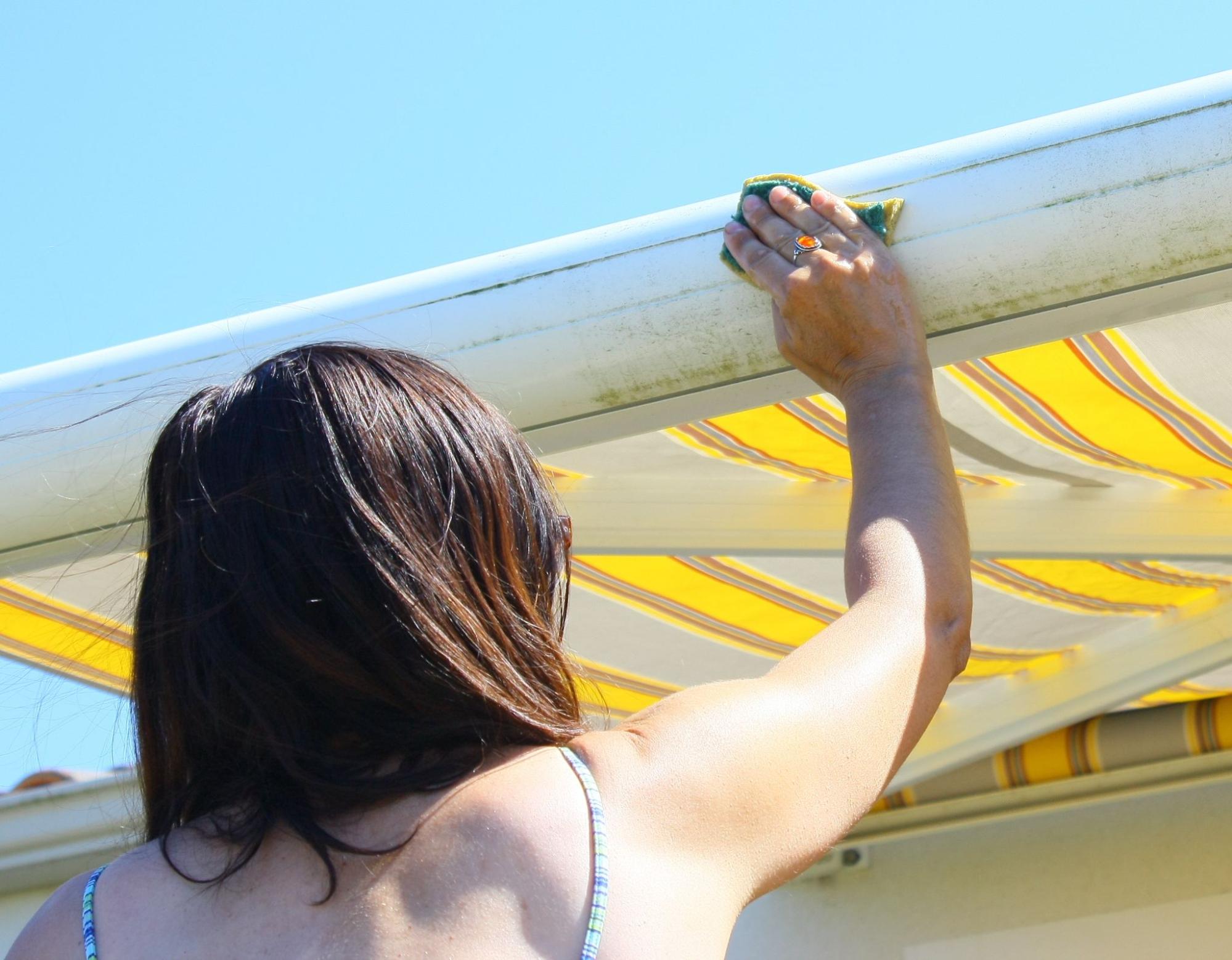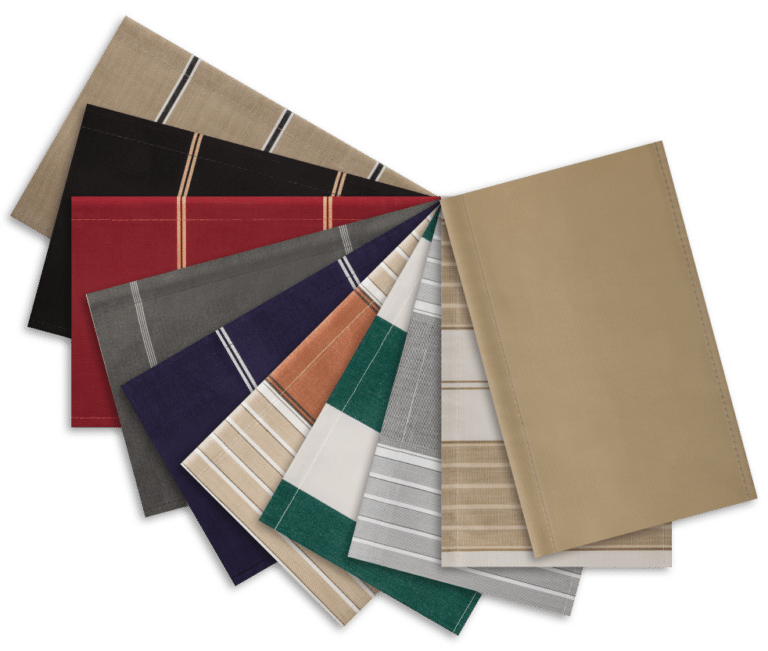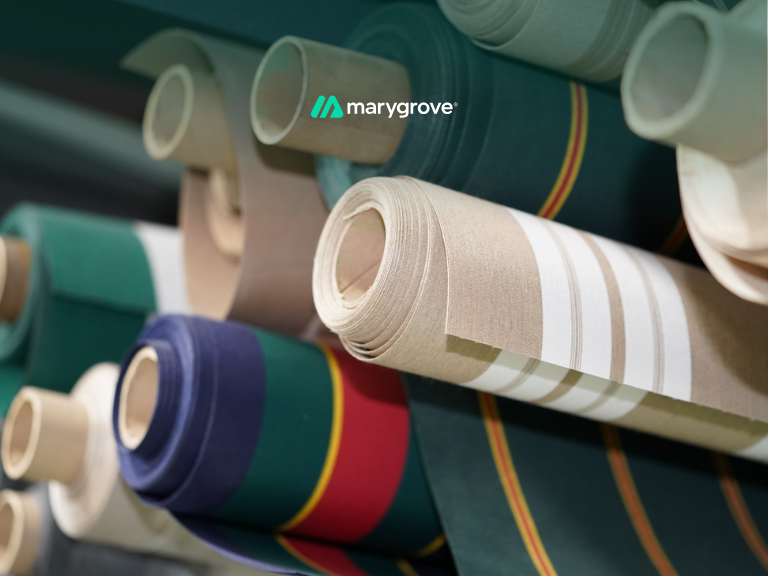Polyester is the best all-around awning fabric for homes due to its UV resistance, mildew control, durability, and ease of maintenance. It handles sun, rain, and daily use better than canvas or cheaper alternatives.
What to Know Before Choosing an Awning Fabric for Your Home
Choosing an awning fabric isn’t just about looks, it affects how your outdoor space handles sun, rain, and daily use.
The right material resists sagging, mildew, and fading, keeping your space functional season after season. Here’s what matters:
- UV resistance prevents fading and weakening
- Mildew resistance is critical in humid climates
- Breathability improves comfort on hot days
- Water resistance helps shed rain and prevent staining
- Durability means less sagging, tearing, or replacing
Polyester checks all the key boxes, while other fabrics vary in fit for residential use. The awning fabric you choose will determine if yours lasts for years, or needs replacing sooner.
This guide helps you get it right from the start.
Why Not All Awning Fabrics Are Created Equal (And Why That Matters)

Awning fabrics aren’t all built the same.
The difference between a high-performance fabric and a budget option can affect how long your awning lasts, how it looks, and how well it protects your outdoor space.
High-Quality Fabrics Last Longer and Perform Better
Some fabrics are engineered to endure years of sun, rain, and wind.
Others start to break down after one season. Lower-cost fabrics often skip essential UV or mildew protection, leading to early fading, sagging, or stretching.
Poor Fabric Can Ruin Outdoor Comfort
A failing fabric doesn’t just look bad, it compromises the entire outdoor experience.
When an awning sags, leaks, or traps heat underneath, it makes your outdoor dining area or patio feel less like a retreat and more like a chore.
Your Climate Should Influence Your Fabric Choice
If you live in a sunny area, prioritize UV resistance.
In humid regions, mildew and stain resistance matter most. Windy areas benefit from heavier, more durable fabrics that hold their shape.
Each environment puts unique stress on fabric.
Cheap Fabrics Lead to Costly Repairs

Homeowners often face sagging fabric, fading colors, or mildew despite using their awning correctly.
These issues stem from material quality, not user error, and they usually mean replacing the fabric sooner than expected.
In the next section, we’ll compare the most common awning fabric types and help you understand which one offers the best long-term value for your home.
Awning Fabric Types Ranked: From Smart Choices to Options You Should Skip

The awning fabric you choose affects how well it performs year-round, impacting durability, comfort, and longevity.
Here’s a ranked breakdown of common fabrics, based on how they’re made and how they handle real outdoor use.
Polyester: The Best All-Around Awning Fabric for Most Homes

Among residential awning fabrics, standard woven polyester stands out for its balanced performance and reliability.
It’s created by spinning long, synthetic polymer threads (derived from petroleum) into a tightly woven, durable fabric.
This lab-made structure resists sun damage, repels mildew, and stays strong in wind and rain. It’s breathable enough for comfort, yet tough enough to last through season after season of use.
- Engineered to resist fading, mold, and UV breakdown
- Fast-drying and lightweight, ideal for retractable systems
- Maintains color and shape in harsh environments
Pros: Strong, color-stable, mildew-resistant, works with smart-home features
Cons: May need occasional re-coating for added water repellency
Polyester offers the best mix of strength, ease, and appearance, especially for patios, decks, and other residential spaces.
Solution-Dyed Acrylic: A Reliable Choice for Sunny Outdoor Spaces

Like polyester, solution-dyed acrylic starts as a synthetic material, this time from petroleum or coal.
It’s melted, extruded into thin threads, and woven into a breathable, fade-resistant fabric. Known for holding its color exceptionally well, it’s a solid pick for sun-heavy regions.
- UV resistance and colorfastness built into each fiber
- Breathable for comfort in high temperatures
- Designed for year-round outdoor exposure
Pros: Excellent color retention, breathable, dependable under sun
Cons: Can retain moisture in humid conditions
A strong performer for high-sun environments.
Olefin: A Decent Middle-Tier Option for Mild Climates

Olefin, also known as polypropylene, is a synthetic fiber made by melting plastic pellets and spinning them into threads.
It offers good moisture resistance and is lightweight, but its UV durability falls short of polyester and acrylic.
Best suited for shaded patios or homes in milder, low-humidity regions.
- Holds up well in dry, moderate climates
- Naturally resistant to mildew and moisture buildup
- Less durable in areas with intense sun exposure
Pros: Lightweight, mildew-resistant, low-maintenance
Cons: Weaker UV resistance, not ideal for extreme conditions
A practical pick for less exposed installations, but not built for long-term performance in demanding environments.
Also Read → Awning vs Canopy vs Pergola: Honest Outdoor Comparison
Cotton Canvas: Traditional Look, Lower Longevity

Canvas is woven from natural cotton threads, giving it a soft, nostalgic look.
However, natural materials like cotton degrade under UV, heat, cold, and moisture. Coatings can be added to resist fading and water, but those coatings are synthetic, and they wear down over time.
- Breathable and visually warm
- Needs regular care to maintain performance
- Natural fiber base breaks down faster than synthetics
Pros: Classic texture and appearance
Cons: Fades, absorbs water, molds easily over time
Best for short-term setups or decorative projects, not ideal for year-round, weather-exposed awnings.
Cheap Online Tarps or Marine Canvas: The DIY Gamble

Low-cost tarps or marine-grade canvases are often used in DIY setups but rarely hold up long-term.
These options usually lack proper UV coatings, are cut-to-size with little quality control, and offer no real warranty.
- Easy to purchase and install
- Built more for short-term coverage than seasonal durability
- Poor breathability and inconsistent quality
Pros: Low cost, widely available
Cons: Weak UV resistance, degrades quickly, no support
Only suitable for temporary shading, not for any permanent or retractable awning system.
Now that you understand what each fabric type brings to the table, let’s look at what they face outdoors, because the real test of any material begins once the weather rolls in.
Why Fabric Quality Is the Backbone of a Long-Lasting Awning

Awnings enhance everyday life, cooling down sunny patios, making outdoor dining more comfortable, and creating shaded retreats by the pool.
But the performance of any awning comes down to one core element: the fabric. Here’s why the quality of that fabric matters more than most people realize.
Fabrics Face Constant Outdoor Stress
Between intense sun, falling debris, and changing weather, outdoor fabric is under daily pressure.
UV rays are especially damaging, causing cheaper fabrics to fade, become brittle, and lose strength quickly.
Add in tree sap, bird droppings, and pollution, and even a newer awning can start to look worn without the right level of protection.
Low-Quality Fabrics Don’t Handle Weather Well
Stretching, sagging, or tearing are common signs of underperforming fabric.
When exposed to wind or heavy rain, low-grade materials often lose shape and tension. This can prevent your awning from retracting properly, reduce its coverage, and shorten its usable life.
Moisture Can Lead to Mildew and Odors
Moisture buildup is another weak point for low-end fabric.
If your awning is retracted while still wet, or sits in a shaded, humid area, mildew can develop quickly. It often leads to stains, unpleasant smells, and gradual breakdown of the material.
High-Quality Fabric Makes a Noticeable Difference

A strong, UV-resistant, mildew-repelling fabric does more than look good, it keeps your awning functional, protects outdoor furniture, and provides lasting comfort in every season.
It’s what makes your space reliably usable.
In the next section, we’ll cover simple fabric care tips that help extend your awning’s lifespan and preserve that fresh, clean look year after year.
Helpful Resource → How Awnings Reduce Heat: Smart Shade for Cooler Homes
How to Extend the Life of Your Awning Fabric (Without the Guesswork)

The right fabric makes your awning functional, but how you care for it plays a huge role in how long that fabric holds up.
Whether you’re shading an outdoor dining area or protecting a lounge space by the pool, a few simple habits can help you get more years out of your investment.
Clean Gently and Consistently
Use a soft-bristle brush and mild soap mixed with water to clean your awning.
A quick rinse with a garden hose is usually enough to remove dust and buildup. Avoid power washing, strong pressure can damage fabric coatings or push water into seams.
Dry Before You Retract
Retracting your awning while it’s still wet is one of the quickest ways to invite mildew and staining.
Let it air-dry fully before rolling it back in, especially after rain or morning dew. A dry fabric is a longer-lasting fabric.
Check Fabric Tension Regularly
Over time, even high-quality fabric can shift slightly. If your awning starts to ripple, sag, or bunch unevenly, it may need a tension adjustment.
Catching this early helps prevent fabric from stretching out of shape or wearing unevenly along the frame.
Use Protective Covers in the Off-Season
If you take down your awning for the winter, store it in a breathable, UV-resistant cover.
This prevents dust buildup, pest damage, and off-season fading, especially if stored near windows or exposed areas.
Let Experts Keep It Tuned Up
If maintenance isn’t your thing or you’d prefer a second set of eyes on your setup, Marygrove’s Mint Program offers seasonal inspections, professional fabric care, and re-tensioning.
It’s a simple way to ensure your awning keeps performing the way it should.
With a little regular care, your awning fabric can stay sharp, strong, and ready for every season of shade and comfort.
Also Read → How Long Do Awnings Last? Lifespan by Type & Care Tips
Final Takeaway: The Right Awning Fabric Turns Outdoor Space Into Living Space

Your awning isn’t just an accessory, it’s a structure that defines how you use and enjoy your outdoor space.
From fabric performance to care habits, every choice impacts comfort, longevity, and ease of maintenance.
Choosing the right fabric ensures your awning does its job: keeping patios cool, protecting furniture, and turning your backyard into a true extension of your home.
With the right care, quality fabric holds its color, shape, and strength season after season.
Whether you’re furnishing a sunny dining nook or a shaded reading spot by the pool, understanding your options gives you control over how your outdoor space feels and functions.
Looking for top-quality fabrics and professional installation you can trust? Explore Marygrove’s awning solutions, designed to last and built for real life.


